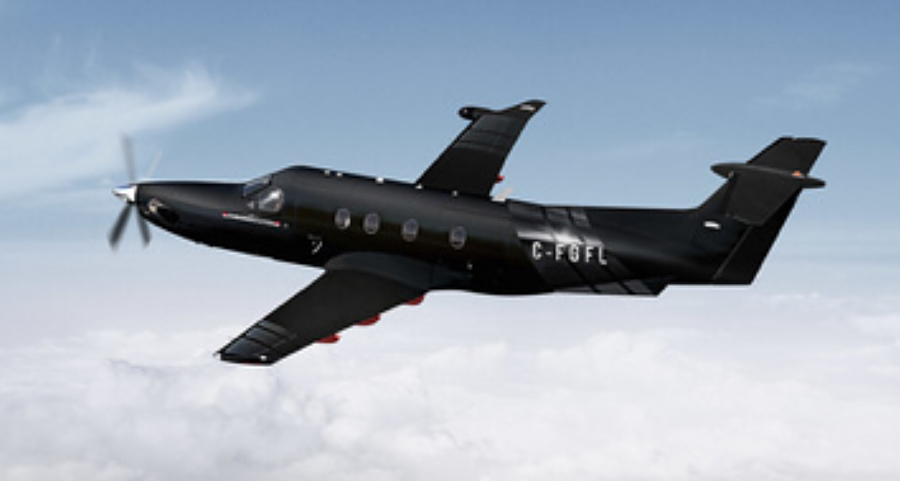A Brief History of the Pilatus PC-12
TIME FLIES
Wartime Creations
Zürich, Switzerland, 1939: An armament company called Oerlikon-Bührle was given the task of performing maintenance and repairs for the Swiss Air Force. They opened a branch specifically for this purpose. Because the founding of the new company occurred alongside the launch of WWII, they needed a location far distant from Switzerland’s borders. The new branch was built right up against a ridge at the base of Mount Pilatus. Thus a new company was born: Pilatus Aircraft. Originally, plans actually called for the plant to be built inside the mountain.
The earliest ventures of the newborn company were to assemble EKW C-35 reconnaissance biplanes from spare parts and reconstruction of other models. Eventually the work evolved into project design and Pilatus Aircraft began producing trademark prototypes. In 1958 Pilatus designed a short takeoff and landing (STOL) light civil transport model known as the PC-6 Porter. The PC-6 first flew on May 4th, 1959. The Porter was also manufactured in the United States by Fairchild Hiller; roughly 100 were completed. In 1966, a turboprop variant of an earlier model, the P-3, was flown and designated the PC-7. The aircraft was lost in a crash and development was put on hold until the 1970’s. Pilatus eventually bought the rights to the all-metal B-4 glider which was redesigned for easier production and rename the B-4/PC-11. The PC-11 first flew on May 5th, 1972 and 322 aircraft of this model were produced.
The PC-12
In 1989 during the month of October, Pilatus disclosed the development of the PC-12. This particular model would become the number one selling pressurized single-engine turbine-powered aircraft on Earth. The information was announced at the National Business Aviation Association’s annual convention. The PC-12 prototype first flew on May 31st, 1991. The Swiss Federal Office of Civil Aviation released the type certificate for the PC-12 on March 30th, 1994. Used mainly for corporate transport and regional airline operators, but its versatility has proven suitable from military and private use. In 1995 the PC-12 Eagle Surveillance aircraft was born, leading to the development of the PC-12 Spectre which was adopted by the United States Air Force as the U-28A. It is powered by a single Pratt & Whitney PT6A-67 engine, although earlier models used the PT6A-67B engine. The PC-12 can operate from short fields, grass, and unimproved runways. Pilatus renovated a plethora of options and improvements on the original model of the PC-12. These included increasingly powerful engines, advancements in noise reduction, increasing maximum takeoff weight, new avionics, upgraded propellers, boosts to both speed and range, and elevated interiors and inflight entertainment. Interestingly, the original meaning of the initials “PC” has been lost to the sands of time. According to a current representative for Pilatus Aircraft, the “P” in all likelihood stood for either “Pilatus” or “Prototype” as both were used. The “C” might have originally stood for “Commercial” but today the initials are simply interpreted as “Pilatus Class.”

The PC-12 NG
In 2007 Pilatus officially launched the PC-12 NG (Next Generation) at the NBAA in Atlanta. The NG features a Pratt & Whitney PT6A-67P engine which boasts more power, enhanced climb performance, and adds increase to maximum cruise speed. Upgrades also include a Honeywell Primus Apex glass cockpit which features cursor controlled inputs to navigation, and automatic pressurization control. The winglets were also modified on the NG. It has such remarkable versatility it performs proficiently in even the most rugged terrain, including the Australian Outback. The cabin can fit up to nine passengers. Other available configurations include seating between six and eight passengers, executive arrangements, and the air ambulance setup can house three attending medics. The interior was designed by BMW’s Designworks division using fine leathers, wood veneers, and a number of different textiles similar to that of a luxury road vehicle. The PC-12 is well known for incorporating a number of safety features. Dual angle-of-attack sensors on the wingtips help counteract potential stalls. There are two separate batteries and a third battery in place for emergencies. It is capable of flying in hazardous and icy conditions and is also well known for possessing easy handling characteristics. The PC-12M (Multipurpose) is equipped with more powerful electrical generation than the NG allowing additional power-consuming equipment to be installed. Thus the PC-12M can perform missions such as aerial surveillance, flight inspection, and air ambulance.
The PC-12NGX
In October of 2019 at the NBAA convention, Pilatus announced the PC-NGX, a model which had already been certified. Fitted with a Pratt & Whitney PT6E-67XP engine, which has low speed propeller mode for noise reduction and includes full authority digital engine control or FADEC. It has 537 km/h cruise, auto throttle feature, touchscreen and cursor control device. The aircraft is highly customizable and capable of meeting numerous mission requirements for a diverse customer base.
The PC-12 has been operated by various distinct and notable customers including:
- United States Air Force
- United States Forest Service
- United States Customs Service
- Red Cross
- Finnish Air Force
- Bulgarian Air Force
- Argentinian Border Guard
- South African Red Cross
- Royal Canadian Mounted Police
- Phoenix Police Department
- Australian Flying Doctor Service
A number of models of the PC-12 have been or are currently deployed in:
- Austria
- Denmark
- France
- Norway
- Switzerland
- Kenya
- Zimbabwe
- India
- Japan
- Belize
- Bermuda
The Pilatus PC-12 has proved time and again to be a reliable, noteworthy aerial asset. It’s lasting reputation will undoubtedly continue to garner respect and admiration from aviation professionals and enthusiasts from around the globe.
Sources:
Special thanks to the following for contributions to this article:
